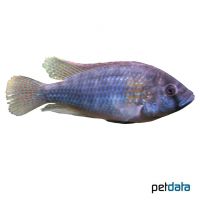Burton's Mouthbrooder (Astatotilapia burtoni)
| Burton's Mouthbrooder Astatotilapia burtoni | |
|---|---|
| Name | Burton's Mouthbrooder |
| Name Lat. | Astatotilapia burtoni |
| Synonym | Haplochromis burtoni |
| Family | Cichlids |
| Family lat. | Cichlidae |
| Order | Cichlids |
| Order lat. | Cichliformes |
| Origin | Lake Tanganyika |
| Habitat | Lakeside, tributaries |
| Diet | Omnivore |
| pH | 7.5-9.0 |
| Behavior | Aggressive |
| Keeping | Harem |
| Care Level | Moderate |
| Reproduction | Mouthbrooder |
| Breeding | Simple |
| Life Span | 5-8 years |
| Protection | No |
| Metric Units | |
| Size | 12-15 cm |
| Temperature | 24-28 °C |
| Hardness | 15-18 °dH |
| Aquarium | 240 l |
| US Units | |
| Size | 4.7"-6" |
| Temperature | 75-82 °F |
| Hardness | 267-320 ppm |
| Aquarium | 65 gal |
Distribution and habitat
The distribution area of Burton's Mouthbrooders is Lake Tanganyika with its inflows and outflows. They live on the shallow shores of the lake with sandy and rocky bottom, as well as the estuaries.
Maintenance
The aquarium setup should have rocky structures that reach the water surface, with plenty of caves, crevices and shelters to provide hiding places, as well as some free sand areas and sturdy aquatic plants for decoration.
There should be no detectable ammonia, ammonium or nitrite, and the nitrate level should not exceed 100 mg/l. To ensure the water quality and oxygen content, a filter and heater adapted to the aquarium size is required, as well as lighting for the species-appropriate day-night rhythm of the animals.
Diet
The food supply consists of live, frozen and dry food. For a balanced diet, feed once a day with a high-quality dry food for cichlids (flakes, granules, pellets) as well as daphnia, artemia, mosquito larvae or mysis (live or frozen). In addition, they need some vegetable food, such as scalded leafy and wild vegetables, algae leaves or dry food with vegetable ingredients (e.g. spirulina)
Only feed as much as will be eaten within a few minutes. A regular and varied diet promotes health and prevents deficiency symptoms.
Behaviour and compatibility
They should be kept in a harem, one male with several females. The territorial males behave aggressively within the species and also towards other fish. Keeping several harems is only possible in a much larger and richly structured tank. A socialization with other cichlids of similar size from Lake Tanganyika is possible.
Basically only compatible fish species with similar demands on water condition and water temperature may be socialized.
Sex dimorphism
The male is much more colorful than the female (sexual dichromatism) and carries egg spots on the anal fin. The female is usually smaller and inconspicuously colored
Reproduction and breeding
They are maternal mouth brooders. The female lays up to 50 eggs in a sand pit. After the male fertilizes the eggs, the female immediately takes them into the throat pouch for mouthbrooding. She keeps the fry in the throat pouch even after they hatch. After about 2 weeks, the fry are released. For a few more days the young fish flee back into the mother's mouth in case of danger before the brood care ends. During the entire brood care the female takes no food.
Fry must be fed several times a day with special rearing food (Artemia nauplii). Breeding is hardly possible in community tanks, as the fry are easy prey.
Important
The harem should consist of at least 4 females, so that the aggression of the male is better distributed.
The well-being of the fish should be checked regularly. The temperature should be checked daily, the pH, hardness and nitrate value at least every 14 days. Regular partial water changes are recommended, even if the contaminant level has not yet reached the upper limit. Sudden changes in water quality should be avoided. Newly introduced fish must be accustomed slowly to the water in the aquarium
Further literature can be found in your pet store.
References
Text: petdata; Image: petdata
Source: BMELV (1998): Tierschutzgutachten - Haltung von Zierfischen (Süßwasser); RIEHL & BAENSCH (2004): Aquarien Atlas Bd. 3, Mergus Verlag; ENGELMANN (2005): Zootierhaltung - Tiere in menschlicher Obhut: Fische, Verlag Harri Deutsch
- Gemäß § 21 Abs. 5 Tierschutzgesetz idgF
